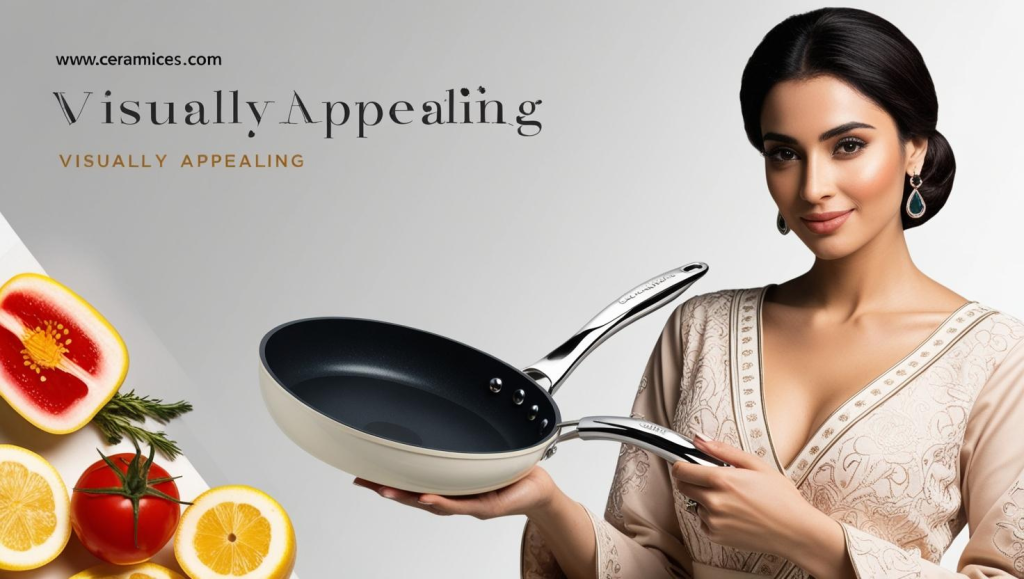Ceramic cookware has gained popularity in recent years as a healthier and more eco-friendly alternative to traditional non-stick pans. But many people wonder, “Is ceramic non-stick?” This guide will explore the non-stick properties of ceramic cookware, explain how it compares to other non-stick options, and answer frequently asked questions. By the end of this article, you’ll have a clear understanding of whether ceramic cookware is non-stick and how to make the most of it in your kitchen.
Why Is Non-Stick Cookware Important?
Non-stick cookware offers several benefits that make it a favorite among home cooks and professional chefs:
- Ease of Cooking: Food slides off easily, reducing the need for excessive oil or butter.
- Easy Cleaning: Non-stick surfaces are simple to clean, often requiring just a quick wipe.
- Healthier Cooking: Less oil is needed, promoting healthier meal preparation.
- Versatility: Non-stick cookware is suitable for a wide range of cooking methods, from frying to baking.
Is Ceramic Non-Stick?

Yes, ceramic cookware is non-stick, but its performance depends on the quality of the ceramic coating and how it is used. Here’s a closer look at what makes ceramic cookware non-stick and how it compares to other non-stick options.
How Does Ceramic Cookware Achieve Non-Stick Properties?
1. Ceramic Coating
Ceramic cookware is typically made with a ceramic-based non-stick coating applied to a metal base (usually aluminum). This coating is derived from natural materials like sand and water, making it free from harmful chemicals like PTFE and PFOA.
2. Smooth Surface
The ceramic coating creates a smooth, glass-like surface that prevents food from sticking. This allows for easy cooking and cleaning.
3. Heat Distribution
Ceramic cookware distributes heat evenly, reducing hot spots that can cause food to stick or burn.
Ceramic vs. Traditional Non-Stick Cookware
1. Health and Safety
- Ceramic: Free from PTFE and PFOA, making it a safer option for cooking.
- Traditional Non-Stick: Often contains PTFE, which can release toxic fumes at high temperatures.
2. Durability
- Ceramic: Generally less durable than traditional non-stick coatings and can wear out over time.
- Traditional Non-Stick: More durable but may degrade if overheated or scratched.
3. Heat Resistance
- Ceramic: Can withstand moderate heat but may degrade at very high temperatures.
- Traditional Non-Stick: Can handle higher temperatures but may release harmful fumes.
4. Eco-Friendliness
- Ceramic: Made from natural materials and is more environmentally friendly.
- Traditional Non-Stick: Often made with synthetic materials that are less eco-friendly.
Tips for Using Ceramic Cookware
- Preheat Properly: Preheat the pan on low to medium heat to avoid damaging the ceramic coating.
- Use Low to Medium Heat: Avoid high heat, as it can degrade the non-stick properties.
- Use Wooden or Silicone Utensils: Avoid metal utensils that can scratch the surface.
- Avoid Cooking Sprays: Use oils or butter sparingly to prevent buildup on the coating.
- Hand Wash: Clean with mild detergent and a soft sponge to preserve the non-stick surface.
Common Mistakes to Avoid When Using Ceramic Cookware
- Overheating: High heat can damage the ceramic coating and reduce its non-stick properties.
- Using Metal Utensils: Metal utensils can scratch the surface, leading to food sticking.
- Stacking Pans: Stacking can cause scratches. Use pan protectors or store separately.
- Using Abrasive Cleaners: Harsh cleaners can damage the ceramic coating. Stick to mild detergents.
How to Maintain the Non-Stick Properties of Ceramic Cookware

1. Season the Pan
- Wash and Dry: Clean the pan thoroughly and dry it completely.
- Apply Oil: Rub a small amount of oil (e.g., vegetable or coconut oil) onto the surface.
- Heat Gently: Heat the pan on low for a few minutes, then let it cool and wipe off excess oil.
2. Clean Gently
- Hand Wash: Use mild detergent and a soft sponge to clean the pan.
- Avoid Dishwashers: Dishwashers can degrade the ceramic coating over time.
3. Store Properly
- Use Pan Protectors: Place a soft cloth or paper towel between stacked pans.
- Hang or Store Separately: If possible, hang pans or store them individually.
FAQs About Ceramic Non-Stick Cookware
1. Is ceramic cookware truly non-stick?
Yes, ceramic cookware has a non-stick coating that prevents food from sticking.
2. How long does the non-stick coating last on ceramic cookware?
With proper care, the non-stick coating can last 1-3 years, depending on usage.
3. Can I use metal utensils with ceramic cookware?
No, use wooden or silicone utensils to avoid scratching the surface.
4. Is ceramic cookware safe at high temperatures?
Ceramic cookware is safe at moderate temperatures but can degrade at very high heat.
5. Can I put ceramic cookware in the dishwasher?
It’s best to hand-wash ceramic cookware to preserve the non-stick coating.
6. How do I remove stains from ceramic cookware?
Use a paste of baking soda and water or a mild ceramic cleaner. Avoid abrasive scrubbers.
7. Can I use cooking sprays on ceramic cookware?
Avoid cooking sprays, as they can leave a residue that reduces non-stick performance.
8. How do I season ceramic cookware?
Apply a thin layer of oil and heat gently to maintain the non-stick surface.
9. Is ceramic cookware better than traditional non-stick?
Ceramic cookware is healthier and more eco-friendly but may be less durable than traditional non-stick.
10. Can I use ceramic cookware on an induction stove?
Only if the cookware has an induction-compatible base. Check the manufacturer’s instructions.
Additional Tips for Using Ceramic Cookware
1. Rotate Usage
Rotate your ceramic cookware to ensure even wear and prolong its lifespan.
2. Avoid Extreme Temperature Changes
Do not expose hot ceramic cookware to cold water, as it can cause cracking.
3. Use Proper Utensils
Always use wooden or silicone utensils to avoid damaging the non-stick surface.
4. Monitor Heat
Cook on low to medium heat to preserve the ceramic coating.
5. Inspect Regularly
Check for scratches or wear and replace the cookware if the coating is damaged.
The Benefits of Ceramic Non-Stick Cookware
1. Healthier Cooking
Ceramic cookware allows for cooking with less oil, promoting healthier meals.
2. Eco-Friendly
Made from natural materials, ceramic cookware is more environmentally friendly.
3. Easy to Clean
The non-stick surface makes cleaning quick and effortless.
4. Versatile
Suitable for a wide range of cooking methods, from frying to baking.
Conclusion
So, is ceramic non-stick? Yes, ceramic cookware is non-stick, offering a healthier and eco-friendly alternative to traditional non-stick options. By understanding how to use and care for ceramic cookware, you can enjoy its benefits for years to come. Whether you’re a seasoned chef or a home cook, ceramic cookware can elevate your cooking experience with its ease of use and versatility.
Remember to follow the tips and guidelines in this article to maintain the non-stick properties of your ceramic cookware. With proper care, you can enjoy delicious, healthy meals and simplify your kitchen routine. Happy cooking!
This extended guide provides a deeper dive into the world of ceramic non-stick cookware, offering additional tips, benefits, and insights to help you handle your cookware with confidence. Whether you’re frying eggs, sautéing vegetables, or baking casseroles, this comprehensive guide has everything you need to know about ceramic non-stick cookware.